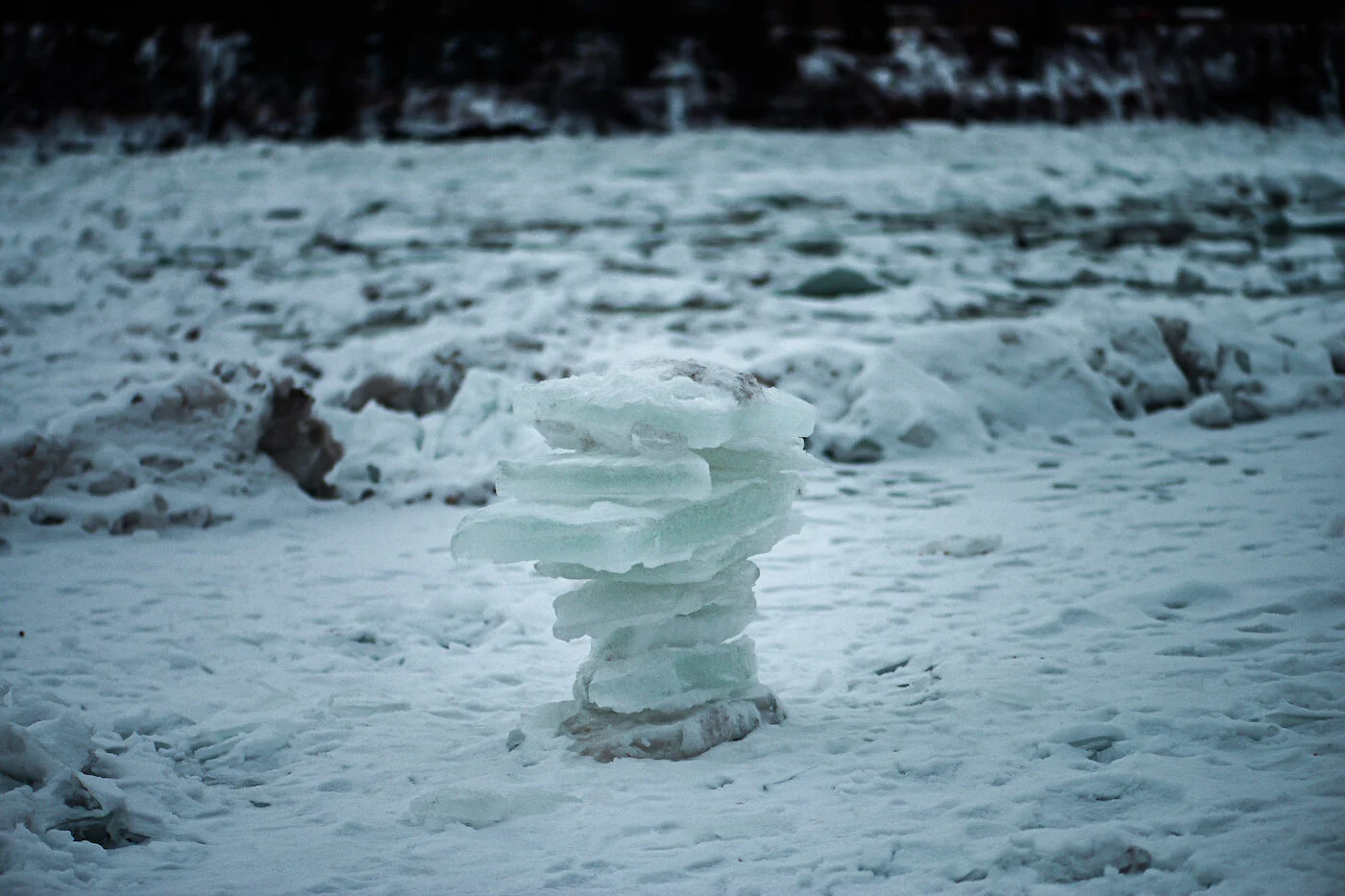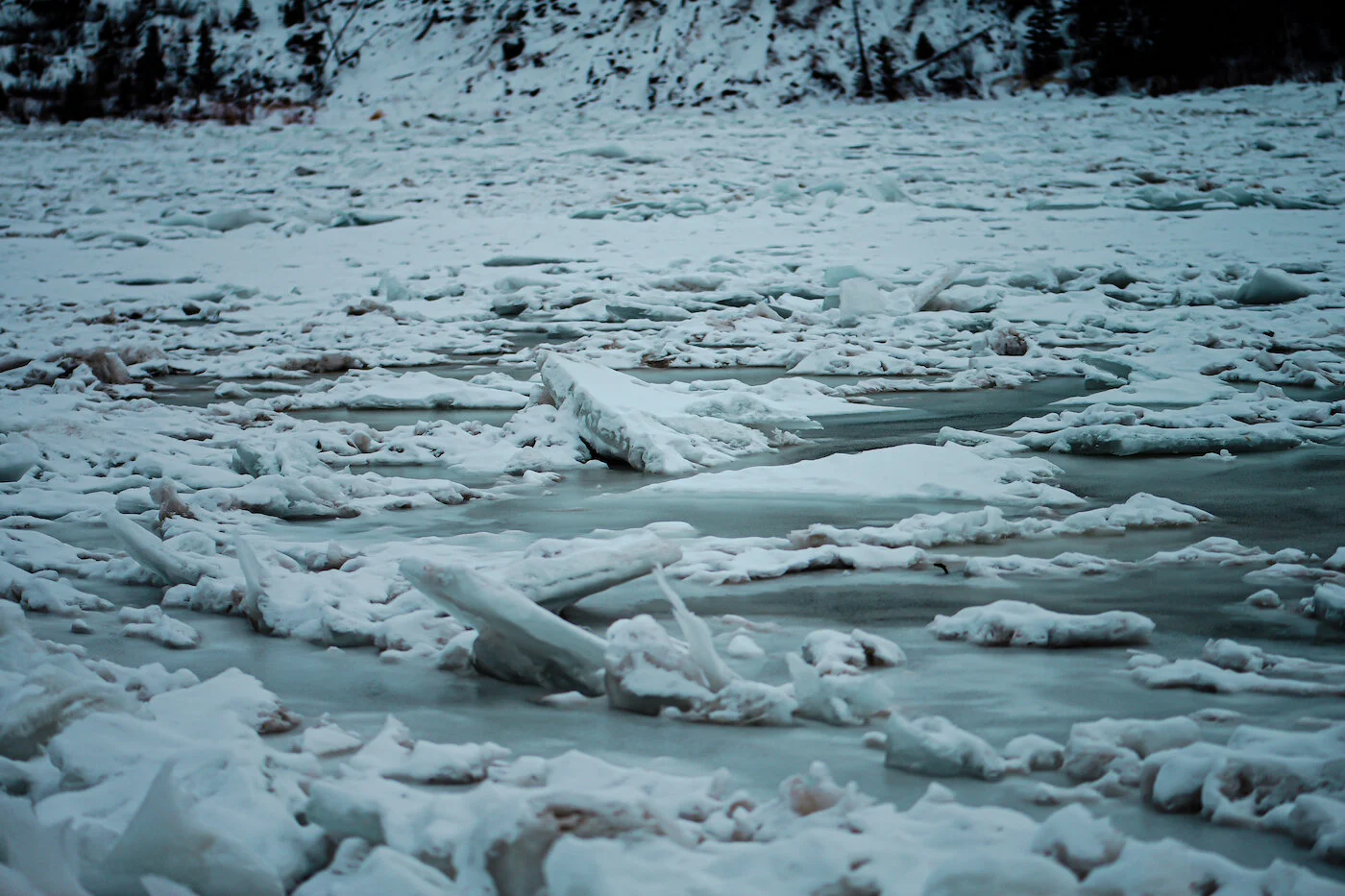Mirage on the Horizon
On January 6th, 2020, which is a date that will be remembered in history, while there was a terrorist attack underway in the United States, I was at the river with our daughter, taking photos, listening to the ice heave and creak. We were safely on the shore, and in the above photo, on the cement boat launch area — though it may look like I’m right out there. People had picked up the shards of ice and made them into inukshuk-like sculptures. We had a go at that too, playing, really with the ice that had offered itself up from the mostly frozen river.
Even though we were at a river, for some reason I thought of the Titanic while we were out there. The low moans of the river, the ice like sinking ships. When I got home it was pretty much doom scrolling, disbelief and the thought — well, of course. We all saw this coming. Still, impossible not to be astonished, sickened. And the thing is, as many have pointed out, it’s not as though this couldn’t happen here. Similar behaviours are certainly in play here, where I live, too.
At a certain point, though, I did stop doomscrolling and took a book of essays about disasters off the shelf, because of my previous thoughts on the Titanic, I guess. I kept thinking that the scene at the river was deeply symbolic. (Let’s not forget the surging river as the ice melts in spring). In the winter, the ice breaks and heaves and freezes, comes to a stop really, even though there is some open water here and there. There’s an inevitability about it, seizing up, getting wrecked. The book is The Unreality of Memory by Elisa Gabbert and begins with a description of a YouTube video of “a computer-animated re-creation of the sinking of the Titanic in real time.” This is in an essay titled “Magnificent Desolation.”
“The strangest thing about the video is that it includes no people — no cartoon passengers. There is no violin music, no voice-over. The ship is lit up, glowing yellow in the night, but the only sound, apart from a few emergency flares and engine explosions, is of water sloshing into and against the ship. The overall impression is of near silence. It’s almost soothing.”
I keep thinking about the musicians on the Titanic, the way they kept on playing. And aren’t we all doing that right now to some extent?
Gabbert talks about how there are new theories about the “root cause of the disaster.” “One scientist thinks that a sudden and extreme drop in t temperature caused a mirage on the horizon that obscured the iceberg from the men in the lookout until they were nearly upon it.”
The essay that I was most drawn to re-read was on compassion fatigue, “I’m So Tired.” I used to think about CF a lot working at the library, but our job there right now is so very different. When I used to think about it, it was because I was busy enacting it. Compassion was immediate, felt, necessary, but it was part of an active stance. But now it’s really more “out there.” We extend it to those we know, but there are so many people living so many difficult things right now it becomes thin and tired. There’s a futility. What can we even do for each other?
Gabbert says, “Empathy, like any bodily process has a cost. Hunger would be meaningless if it didn’t make you eat. What good is compassion if it doesn’t translate into concrete, external action?” says Gabbert. She also says, “Just opening Twitter on your phone or looking at the TV in a bar could be a form of secondary trauma: exposure to enormous problems you can’t possibly solve.”
The philosophers of the past didn’t have the same mechanisms to deal with as we do now. She says, “Social media, twenty-four-hour news, alerts on my iPhone — the demands on our compassion are much higher than a cave dweller or Kant had to contend with. It’s overwhelming, even paralyzing…”
You wouldn’t think that a book of essays on disasters would make you feel better, but somehow it did make me feel better. Because it’s less about disasters and more about, as she says, the way we think about them. She says on the end of the world, “I’m not sure the doom will occur like a moment, like an event, like a disaster. Like the impact of a bomb or an asteroid. I wonder if the way the world gets worse will barely outpace the rate at which we get used to it.”
She also notes that her research into disasters was comforting. “We’re still here, after all.” But goes on to say: “But I can only take so much comfort in the past. This point in history does feel different, like we’re nearing an event horizon. How many times can history repeat itself?” She wrote this before Covid, before these recent events, obviously. But you have to hope that this is some kind of a turning point.
We’re seeing more, the fog is lifting, the mirage is revealed as a mirage, even though most people were calling the iceberg an iceberg all along. A disaster, as it recedes into the past, can be analyzed, dissected, essays can be written about them. Questions, new questions will be formed. How did we get used to this? How inevitable was it?
Maybe it’s naive to just ask, when we’re deep in the thing, how are we to get through to the end of disaster? To the other side? Are we to be musicians playing on a sinking ship? Maybe?
You’ve heard me talk about a strategy I’ve used to get through to this point, which is to do one fun thing every day.
I recently read the inspiring article on Neil Pearte, drummer from Rush, in Rolling Stone Magazine and here’s the quotation I keep coming back to:
“What’s the most excellent thing I can do today?” he used to ask himself.
So maybe that’s a better way to put it. Either way, I don’t think it’s frivolous.
The best ideas, creative ideas, and I think going forward we’re going to need a LOT of those, comes out of play, out of different ways of thinking. If you want to get rid of brain fog, see things in a new way: do something fun, do something excellent. Or, I don’t know, go down to the river and play with ice shards. Do something excellent and then write about it, or sing about it. Because that’s worth something. It’s worth a lot.
In the video Gabbert talks about, there’s no violin music, just the noise of the water sloshing. It’s soothing, she says. But in real life, disasters aren’t calm, nor do we want them to be.













